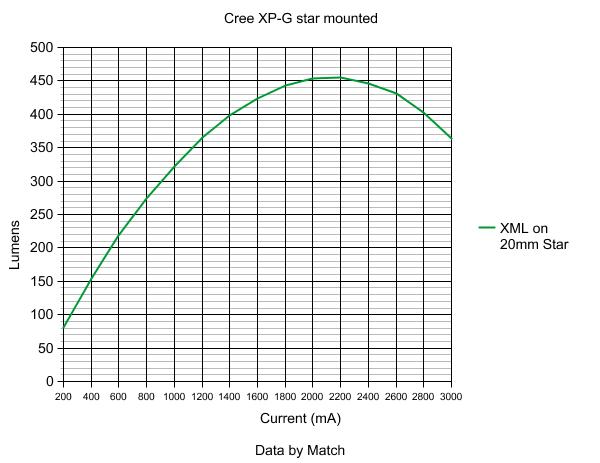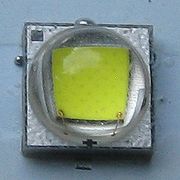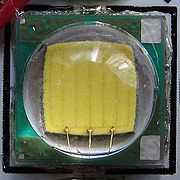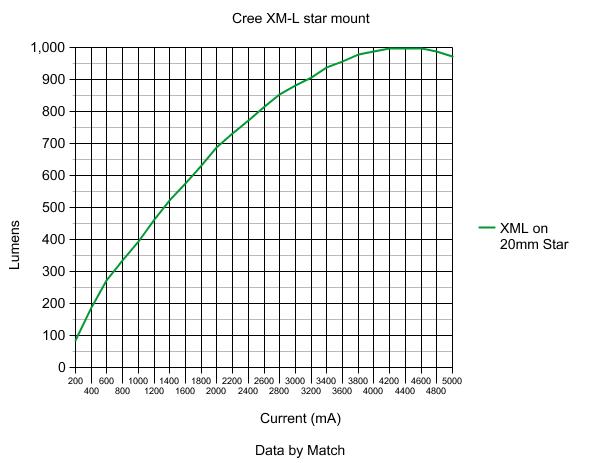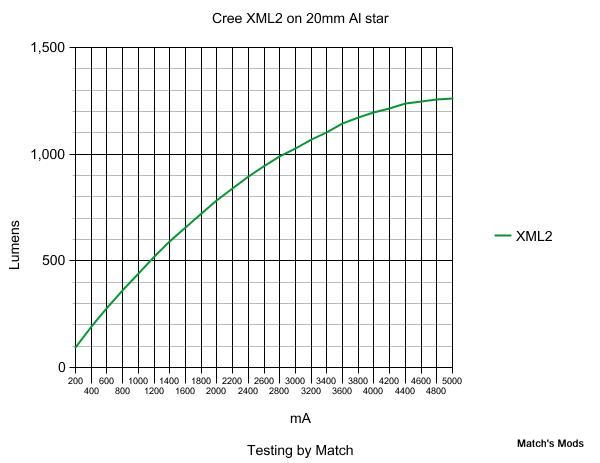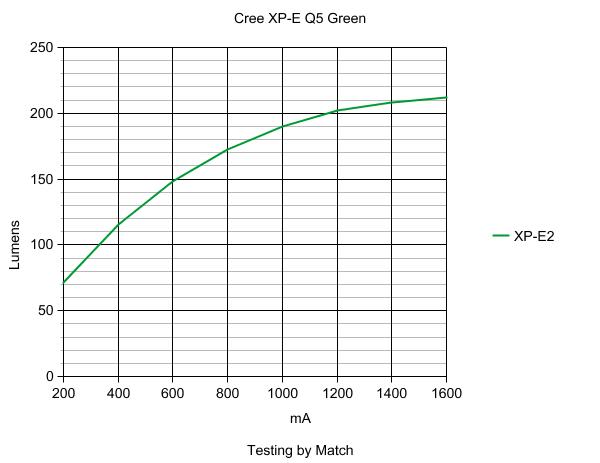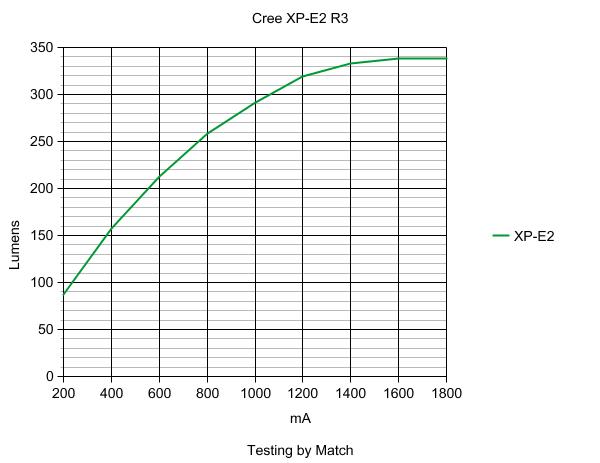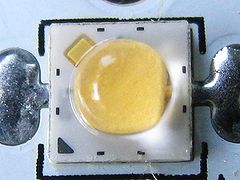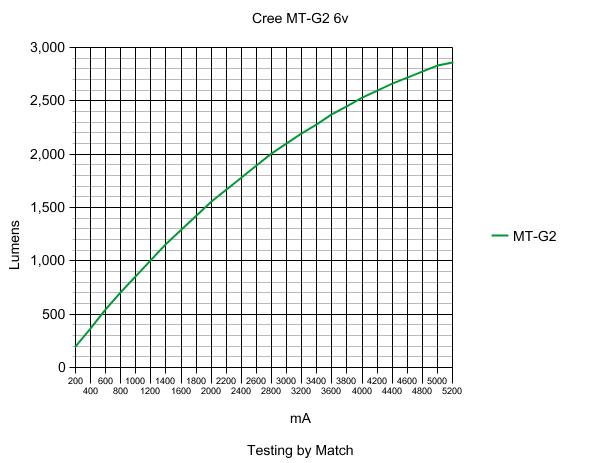I would suggest reading my guide on tint, binning, and CRI before reading this.
This is a comparison between all of the common LEDs. The LEDs included are: XP-G, XP-G2, XM-L, XM-L2, XR-E, XP-E, XP-E2, Nichia 219, SSC-P7, MC-E, SST-50, SST-90, MT-G2
XP-G
The XP-G is a small Cree LED that is 3.45 mm by 3.45mm. The size of the die is 1.4mm by 1.4mm for a total die surface of 1.96mm2 which is often simplified to 2mm2. It is distinguishable by it's size and the grid of 4 strips.
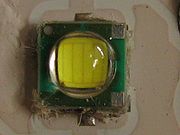
It has 7 brightness bins ranging from R2 to S4. They go in the order of: R2, R3, R4, R5, S2, S3, and S4. It is generally driven up to 1.5 amps, but had been driven higher with better heatsinks.
Bin 350mA 700ma 1000mA 1500mA
R2 114-122 213-228 285-305 380-406
R3 122-130 228-243 305-325 406-433
R4 130-139 243-260 325-348 433-463
R5 139-148 260-277 348-370 463-493
S2 148-156 277-292 370-390 493-520
S3 156-164 292-307 390-410 520-547
S4 164-172 307-322 410-430 547-573
Note: These are emitter lumens. OTF lumens once it is installed in a flashlight will be less.
The XP-G is generally used in smaller lights due to the smaller size of it. It also can be more effective in throwers due to the small die size compared to the XM-L.
This graph is measured when the junction temperature is 25 degrees Celsius. When used in a flashlight it will be at a higher temperature so this data is only approximate.
The XP-G can run on as little as 2.5 volts (moonlight) but in most cases the vf (forward voltage) is closer to 3-3.5 volts.
Going by this data the XP-G can go up to 2 amps before the law of diminishing returns kicks in.
The XP-G uses the same method of rating tints as the XM-L. It does come in a Hi-CRI version that does 90 cri; at the expense of efficiency and being 3000k. (WW)
The datasheet can be found
here.
It can be purchased in many places. Intl-outdoor has a great selection of them in a variety of tints.
http://www.intl-outdoor.com/led-xpg-c-107_127.html?page=1&sort=20a
XP-G2
The XP-G2 is the successor to the XP-G. It is more efficient along with having a different die design. It was originally introduced in July 2012. It also is 3.45 mm by 3.45 mm with a die size of 1.4 mm*1.4mm. (1.96mm2) It can be identified by its size along with its lack of a grid.
It has 6 brightness bins ranging from Q4 to R5. They are: Q4, Q5, R2, R3, R4, and R5.
Bin 350mA 700mA 1000mA 1500mA
Q4 113-121 206-220 275-294 373-399
Q5 121-129 220-235 294-313 399-425
R2 129-138 235-252 313-336 425-454
R3 138-147 252-268 336-357 454-485
R4 147-157 268-287 357-382 485-518
R5 157-170 287-310 382-412 518-558
Note: These are emitter lumens. OTF lumens once it is installed in a flashlight will be less.
Note2: I took this data from FlashlightWiki so it was multiplied by 13% to account for them being binned at higher temperatures than XP-Gs. If you do not understand this ignore it.
As the successor to the XP-G, the XP-G2 is used in the same category of lights. Due to it being released recently it has not found its way into budget lights yet, but it most likely will in the future.
The vf (forward voltage) of the XP-G2 ranges from 2.8 volts 3.3 volts depending on how hard it is being driven.
Along with being more efficient, the XP-G2 can handle more current before it reaches the point of diminishing returns. (At 2.6 amps) Compared to the XP-G which puts out 450 lumens at 2 amps, the XP-G2 puts out 525 lumens.
Like the XP-G it also comes in a Hi-CRI version, however since it is a new LED it cannot be found anywhere for sale.
The datasheet can be found
here.
Intl-Outdoor has a fairly good selection of them, in a variety of tints.
http://www.intl-outdoor.com/led-xpg-c-107_127.html?page=1&sort=20a
XM-L
The XM-L first became available in December 2010. It is a 5 mm*5 mm LED with a die size of 2 mm*2 mm. (4mm2) It is one of the larger LEDs that Cree makes and can be identified the 6 strips in a grid across it.
It has 7 brightness bins ranging from T2 to U3. They are: T2, T3, T4, T5, T6, U2, and U3.
Bin 700mA 1000mA 1500mA 3000mA
T2 200-220 275-303 390-429 650-715
T3 220-240 303-330 429-468 715-780
T4 240-260 330-358 468-507 780-845
T5 260-280 358-385 507-546 845-910
T6 280-300 385-413 546-585 910-975
U2 300-320 413-440 585-624 975-1040
U3 320-340 440-468 624-663 1040-1105
Note: These are emitter lumens. OTF lumens once it is installed in a flashlight will be less.
The XM-L is generally used in lights that run on Li-ion batteries due to it needing large amounts of current. It is used in a number of throwers due to its large output.
Note: This graph is measured when the junction temperature is 25 degrees Celsius. When used in a flashlight it will be at a higher temperature so this data is only approximate.
This graph shows that the XM-L needs between 2.5 volts and 3.4 volts to operate.
The XM-L can handle up to 4.4 amps in this instance before it reaches the point of diminishing return. Due to the extremely large amount of heat that is being generated here a large heatsink with adequate surface area is a must.
The XM-L can be found in a number of different tints, which is covered very thoroughly in
this thread.
The XM-L can be bought most anywhere, but as usual I will recommend Intl-Outdoor.
http://www.intl-outdoor.com/led-xml-c-107_125.html
XM-L2
The XM-L2 is the successor to the XM-L, it first became available in December 2012. Like the XM-L it is a 5 mm*5 mm LED with a die size of 2 mm*2 mm. (4mm2) Unlike the XM-L it does not have a grid on the die.
It has 9 brightness bins ranging from S4 to U2. They are: S4, S5, S6, T2, T3, T4, T5, T6, and U2.
Bin 700mA 1000mA 1500mA 3000mA
S4 186-196 256-268 360-377 612-641
S5 196-207 268-284 377-400 641-679
S6 207-227 284-313 400-439 679-746
T2 227-250 313-343 439-483 746-820
T3 250-273 343-375 483-528 820-895
T4 273-296 375-406 528-571 895-970
T5 296-318 406-438 571-615 970-1044
T6 318-341 438-468 615-659 1044-1119
U2 341-364 468-500 659-703 1119-1193
Note: These are emitter lumens. OTF lumens once it is installed in a flashlight will be less.
Note2: I took this data from FlashlightWiki so it was multiplied by 13% to account for them being binned at higher temperatures than XP-Gs. If you do not understand this ignore it.
To date the XM-L2 has not been used in any lights. Vinhnguyen is taking preorders for a XM-L2 P60 drop in but they have not been produced yet. However, one could expect them to be used in the same lights as XM-Ls once they have fully entered the market.
This graph shows that the XM-L2 needs between 2.7 and 3.4 volts to operate.
Since the XM-L2 is extremely new there is no lumen testing that has been done on it. For that reason I have created a graph based on the approximate lumen values supplied in the datasheet. I assumed it was a XM-L2 U2. Obviously, this graph does not tell us anything new.
So far the XM-L2 can only be bought in NW or CW. The advantage is that a NW T6 XM-L2 is equal to a NW U3 XM-L. As there never was a NW U2, let alone a U3 this is a huge advantage.
The datasheet can be found
here.
So far they only can be purchased from
Mouser. As time passes they will most likely be available from more sources.
XR-E
The XR-E is one of the oldest Cree LEDs, it was attached to a 9mm by 7mm substrate. Despite the extremely large board, it has a tiny die. There are two different die sizes. The EZ1000 which was 1mm by 1mm. Later on the EZ900 one was released which had a .9mm by .9mm die. (EZ1000 on left and EZ900 on right)
It has 10 brightness bins ranging from N3 to R2. They go N3, N4, P2, P3, P4, Q2, Q3, Q4, Q5, and R2.
Bin 350 ma
N3 56.8
N4 62
P2 67.2
P3 73.9
P4 80.6
Q2 87.4
Q3 93.9
Q4 100
Q5 107
R2 114
Note: These are emitter lumens. OTF lumens once it is installed in a flashlight will be less.
Due to the extremely small die size the XR-E is often used in dedicated throwers. For example the DEFT EDC used it, as did basically every other custom throw king. People do not use it in flood lights due to its low lumen output.
Note: This graph is measured when the junction temperature is 25 degrees Celsius. When used in a flashlight it will be at a higher temperature so this data is only approximate.
The XR-E needs between 2.3 volts and 3.7. It generally has a vf of around 3.3 volts. As someone else pointed out, XR-Es doe require a higher voltage than a XP-G.
In this instance the XR-E can handle up to 2.1 amps before hitting the point of diminishing returns. In throwers it is generally driven around that level. The newer XR-Es are reported to pull up to 2.5 amps while still increasing in brightness, but this is unconfirmed.
The XR-E is hypothetically available in tints ranging from CW to WW, but the usual sites do not seem to sell anything other than CW.
Datasheet can be found
here.
LedSupply has a great selection of XR-Es in a variety of colors.
http://www.cree.com/~/media/Files/Cree/LED%20Components%20and%20Modules/XLamp/Data%20and%20Binning/XLamp7090XRE.pdf
XP-E
In September 2008 the XP-E was released. It is 3.45mm*3.45mm with a die that is 1mm*1mm. It has a grid with 3 strips.
It has 8 brightness bins ranging from P4 to R4. They go in the order: P4, Q2, Q3, Q4, Q5, R2, R3, and R4.
Bin 350mA 700mA 1000mA
P4 80.6-87.4 137-149 177-192
Q2 87.4-93.9 149-160 192-207
Q3 93.9-100 160-170 207-220
Q4 100-107 170-182 220-233
Q5 107-114 182-194 233-251
R2 114-122 194-207 251-268
R3 122-130 207-221 268-286
R4 130-139 221-236 286-306
Note: These are emitter lumens. OTF lumens once it is installed in a flashlight will be less.
XP-Es are generally used in the same lights as XP-Gs. They are small and do not require very much current, perfect for lights that use a boost driver. The low lumen output does not matter in this type of light as the driver can only supply so much current.
Note: This graph is measured when the junction temperature is 25 degrees Celsius. When used in a flashlight it will be at a higher temperature so this data is only approximate.
Note2: Ignore the green line, it is for green XP-Es.
XP-Es generally need around 3-3.5 volts depending on the current.
Note: This is for a Green XP-E I couldn't find data for a white one so I used this. It is most likely fairly close to a white XP-E.
The XP-E goes up to 1.6 amps without reaching the point of diminishing returns. Sadly, it does not get very bright despite the high currents.
The XP-E is commonly available in CW along with green and red.
Datasheet can be found
here.
Intl-Outdoor has a good selection of them.
http://www.intl-outdoor.com/led-xpe-c-107_126.html?page=1&sort=20a
XP-E2
The XP-E2 is the successor to the XP-E, it was released in September 2012. Like the XP-E it is 3.45mm*3.45mm with a die that is 1mm*1mm. Unlike the XP-E it does not have a grid of bond wires. It is approximately 20% brighter than the XP-E.
It has 9 brightness bins ranging from P2 to R3. They are: P2, P3, P4, Q2, Q3, Q4, Q5, R2, and R3.
Bin 350mA 700mA 1000mA
P2 78.0-85.7 133-147 171-187
P3 85.7-93.5 147-160 187-204
P4 93.5-101 160-174 204-222
Q2 101-109 174-187 222-238
Q3 109-116 187-198 238-253
Q4 116-124 198-212 253-270
Q5 124-132 212-226 270-289
R2 132-142 226-242 289-309
R3 142-151 242-258 309-329
Note: These are emitter lumens. OTF lumens once it is installed in a flashlight will be less.
Note2: I took this data from FlashlightWiki so it was multiplied by 13% to account for them being binned at higher temperatures than XP-Gs. If you do not understand this ignore it.
The XP-E2 can be used in any place a XP-E is used. So it will be used in small lights, but so far very few lights have adopted it. Vinhnguyen, a member of CPF, does make P60 drop ins with them.
This graph shows that the vf of a XP-E2 is generally between 2.8 and 3.2 volts depending on the current.
The XP-E can handle currents up to 1.6 amps before it reaches the point of diminishing return. Most lights tend to drive it with less current, generally around 1 amp.
The XP-E2 is hypothetically available in tints ranging from CW to WW, but so far I have only seen CW.
Digikey has a large selection of XP-E2 emitters.
http://www.digikey.com/product-highlights/us/en/cree-xlamp-xp-e2/2612
Nichia 219
The Nichia 219 is a LED that has exploded in popularity recently. It has an extremely high CRI at 92, while being NW. Most LEDs that are 92 CRI are 3000k, not the 4500k of this LED.
Note: While this LED is supposed to be 4500k, the newest ones coming from IS are closer to 4200-4300k.
It comes in brightness bins ranging from B07 to B14. They are: B07, B08, B09, B10, B11, B12, B13, and B14.
Bin 350mA 700mA 1000mA 1500mA
B07 70-80 131-150 175-200 239-273
B08 80-90 150-168 200-225 273-307
B09 90-100 168-187 225-250 307-341
B10 100-110 187-206 250-275 341-375
B11 110-120 206-224 275-300 375-409
B12 120-130 224-243 300-325 409-443
B13 130-140 243-262 325-350 443-477
B14 140-150 262-280 350-375 477-512
Note: These are emitter lumens. OTF lumens once it is installed in a flashlight will be less.
Note2: The Hi-CRI Nichia 219 (type H-1) only goes up B10 bin. This is because in order to get a Hi-CRI they must have a larger ratio of red to other colors. To do this they block select amounts of non-red colors.
Note: This graph is measured when the junction temperature is 25 degrees Celsius. When used in a flashlight it will be at a higher temperature so this data is only approximate.
The Nichia 219 has a much higher forward voltage than other Cree LEDs. It ranges from 3 volts to 4 volts depending on current level.
The Nichia 219 can handle up to 2 amps in this test, but the amount it increases by is rapidly dropping.
The advantage to the Nichia 219 is the Hi-CRI, due to this the other tints are not used since they are not Hi-CRI.
Illumination supply stocks the Nichia 219.
https://illuminationsupply.com/nichia-leds-c-39.html
SSC-P7
The SSC-P7 was one of the first LEDs to be over 500 lumens. It originally was released in 2008 (I think) and is made up of 4 dies. It was made by SeoulSemiConductors, a competitor to Cree. Each die is 1mm by 1mm and they are all wired in parallel. The SSC-P7 was recently discontinued.
It came in many different brightness bins, but the most commonly used ones were A, B, C, D, and E.
Bin 1400mA 2800mA
A 251-326 440-570
B 326-400 570-700
C 400-457 700-800
D 457-514 800-900
E 514-629 900-1100
Note: These are emitter lumens. OTF lumens once it is installed in a flashlight will be less.
When it first came out it was one of the brightest LEDs ever. For this reason it was used in all kinds of lights. Due to the multi-die structure there was often a cross in the beam image, whether it was used with a reflector or an aspheric lens.
The SSC-P7 has a fairly high vf, and for this reason the bins with a lower vf were very rare.
Note: The pink line is passively cooled and the purple line is actively cooled with a fan.
The SSC-P7 maxes out at 5.6 amps in this test, but it is generally driven closer to 3 amps. Due to the large amount of heat generated a large heatsink is a must. While it may seem that it could be brighter than an XM-L, in reality the XM-L will beat it; both in brightness and efficiency.
It was extremely popular at the time, but fell out of favor due to: the high vf, high cost, large size, and low efficiency.
Datasheet is available
here.
It is not for sale anywhere as it was discontinued.
MC-E
The MC-E was the Cree version of the P7. It uses 4 1mm*1mm dies. Unlike the P7 each die can be individually controlled, this means one can wire it 4S, 2S2P, or 4P. They also produced a MC-E with a Red, Blue, Green, and White die; this was used in the Quark RGB along with other custom lights. It had a much smaller footprint than the P7 and was star mounted.
It came in 6 brightness bins: H, J, K, M, N, and P.
Bin 1400mA 2800mA
H 280-320 490-560
J 320-370 560-648
K 370-430 648-753
M 430-490 753-858
N 490-550 858-962
P 550-620 962-1085
Note: These are emitter lumens. OTF lumens once it is installed in a flashlight will be less.
Note2: This assumes they are wired in parallel. Each die is getting 1/4 of that. (350 ma and 700 ma)
The MC-E was used in all kinds of lights, especially ones that wanted maximum brightness. It also was used in RGB lights since it came with 4 dies of separate colors.
Note: This graph is measured when the junction temperature is 25 degrees Celsius. When used in a flashlight it will be at a higher temperature so this data is only approximate.
The vf of it when wired in parallel (white) is generally around 3.2-3.5 volts.
Note: As usual this assumes it is wired in parallel.
The MC-E reaches the point of diminishing return around 5 amps. Despite using the same dies as the P7, the P7 was favored by modders since it could handle high currents and being direct driven better.
The RGB MC-E is available from Intl-Outdoor.
http://www.intl-outdoor.com/cree-mce-color-led-20mm-mcpcb-p-644.html
SST-50
The SST-50 was one of the first high powered LEDs. It is made by Luminous, a competitor of Cree. Due to the large price (20-30 dollars) it is generally not used in budget lights. It is attached to a 7.3mm by 9mm substrate. The die has a surface area of 5mm2. (2.2mm*2.2mm)
Note: While the specs of the SST-50 are great it does not do very well in flashlights, often dying a premature death. Active cooling or a large surface area (fins) is a definite must for this light.
Note: The LED is shown on a Cree star board despite being made by Luminous.
The SST-50 comes in 5 bins: G, H, J, K, and L.
Bin 1750mA 2800mA 5000mA
G 275-350 440-560 743-945
H 350-425 560-680 945-1148
J 425-500 680-800 1148-1350
K 500-600 800-960 1350-1620
L 600-700 960-1120 1620-1890
Note: These are emitter lumens. OTF lumens once it is installed in a flashlight will be less.
The SST-50 is generally used in higher end lights, along with small pocket rockets.
Note: This graph is measured when the junction temperature is 25 degrees Celsius. When used in a flashlight it will be at a higher temperature so this data is only approximate.
The vf of the LED is generally between 3 volts and 3.8 volts depending on the current.
Despite what the rating of the LED is, it can go up to 6 amps and beyond. This means it is better to use the SST-50 rather than the XM-L if the drive current is over 4 amps.
Mouser sells the SST-50 LED here.
http://ca.mouser.com/ProductDetail/Luminus-Devices/SST-50-W45S-F21-GJ401/?qs=sGAEpiMZZMsyM1rGGtQxrJqmQH6ll2Gi
SST-90
The SST-90 is one of the brightest single die LEDs. It is mace by Luminous, a competitor of Cree. Like the SST-50 it is rather expensive so is not commonly used. It is attached to a 10mm by 11mm substrate. The die is 3mm*3mm for a total area of 9mm2.
The SST-90 comes in 5 bins: L, M, N, P, and Q.
Bin 3150mA 5000mA 9000mA
L 600-700 930-1085 1620-1890
M 700-850 1085-1318 1890-2295
N 850-1000 1318-1550 2295-2700
P 1000-1200 1550-1860 2700-3240
Q 1200-1450 1860-2248 3240-3915
Note: These are emitter lumens. OTF lumens once it is installed in a flashlight will be less.
The SST-90 is often used in large reflectored throwers due to the massive output. An example of this would be the SR90.
The vf of the SST-90 is generally around 3.6-3.7 volts when in use. It is because of this that people experimented with LED burn ins to reduce the vf.
The SST-90 can go up to 9 amps and well beyond as demonstrated by this graph. It does so while putting out over 2000 lumens.
Mouser sells the SST-90 here.
http://ca.mouser.com/ProductDetail/Luminus-Devices/SST-90-W57S-F11-GN200/?qs=sGAEpiMZZMsyM1rGGtQxrI8dTF8bA2Y5
MT-G2
The MT-G2 was released in April of 2012 and only recently has made its way into custom flashlights. Unlike most LEDs it has a vf of around 6 volts. (I am focusing on the 6v version) This allows it to run at 6 volts and 3 amps and still produce over 2000 lumens. It is attached to a 9.1mm by 9.1mm substrate.
It comes in 9 bins: E, F, G, H, J, K, M, N, and P.
Bin 1100 mA
E 506
F 552
G 598
H 644
J 690
K 748
M 805
N 863
P 920
Note: These are emitter lumens. OTF lumens once it is installed in a flashlight will be less.
So far it has only been used in custom lights. An example of this is Match's 4M, a minimag running off of 2 IMR 14500s.
This shows that the vf will be between 5.75 volts and 6.25 volts the majority of the time.
This shows that the MT-G2 can handle current far above the rated 3 amps. At 5 amps it is still increasing and has already reached over 2700 lumens.
It can be bought here.
http://www.cutter.com.au/proddetail.php?prod=cut1381&cat=167
Feel free to correct me on any mistakes I made, whether they be grammar or technical. ;)
Source List/Bibliography
I realized I should give credit to the people who did tests that I took data from, so that is all here. :)
- XP-G
- Picture of LED is from Flashlight Wiki
- Data is from Cree Datasheet/FlashlightWiki
- Lumen test by Match
- XP-G2
- Picture of LED is from Flashlight Wiki
- Data is from Cree Datasheet/FlashlightWiki
- vf and lumen graphs from Match
- XM-L
- Picture of LED and Bin data from Cree Datasheet/FlashlightWiki
- lumen graph by Match
- XM-L2
- Picture of LED and Bin data from Cree Datasheet/FlashlightWiki
- Lumen graph by Match
- XR-E
- Picture of LED and Bin data from Cree Datasheet/FlashlightWiki
- Lumen graph by Match
- EZ900 v/s EZ1000 comparison picture: here
- XP-E
- Picture of LED and Bin data from Cree Datasheet/FlashlightWiki
- Lumen Graph by Match
- XP-E2
- Picture of LED and Bin data from Cree Datasheet/FlashlightWiki
- Lumen graph by Match
- Nichia 219
- Picture of LED and Bin data from Nichia Datasheet/FlashlightWiki
- Lumen graphy by Match
- SSC-P7
- Picture of LED and Bin data from SSC-P7 Datasheet/FlashlightWiki
- Graph of vf and lumen output by "jtr1962" (Member of CPF)
- MC-E
- Picture of LED and Bin data from Cree Datasheet/FlashlightWiki
- Lumen graph by Match
- SST-50
- Picture of LED and Bin data from Luminous Datasheet/FlashlightWiki
- Lumen graph by Match
- SST-90
- Picture of LED and Bin data from Luminous Datasheet/FlashlightWiki
- Lumen graph by "Mike cz" (Member of CPF)
- MT-G2
- Picture of LED and Bin data from Cree Datasheet/FlashlightWiki
- Lumen graph by Match
So to everyone who's images/data I used, thank you and if you would like it removed for any reason PM me.


